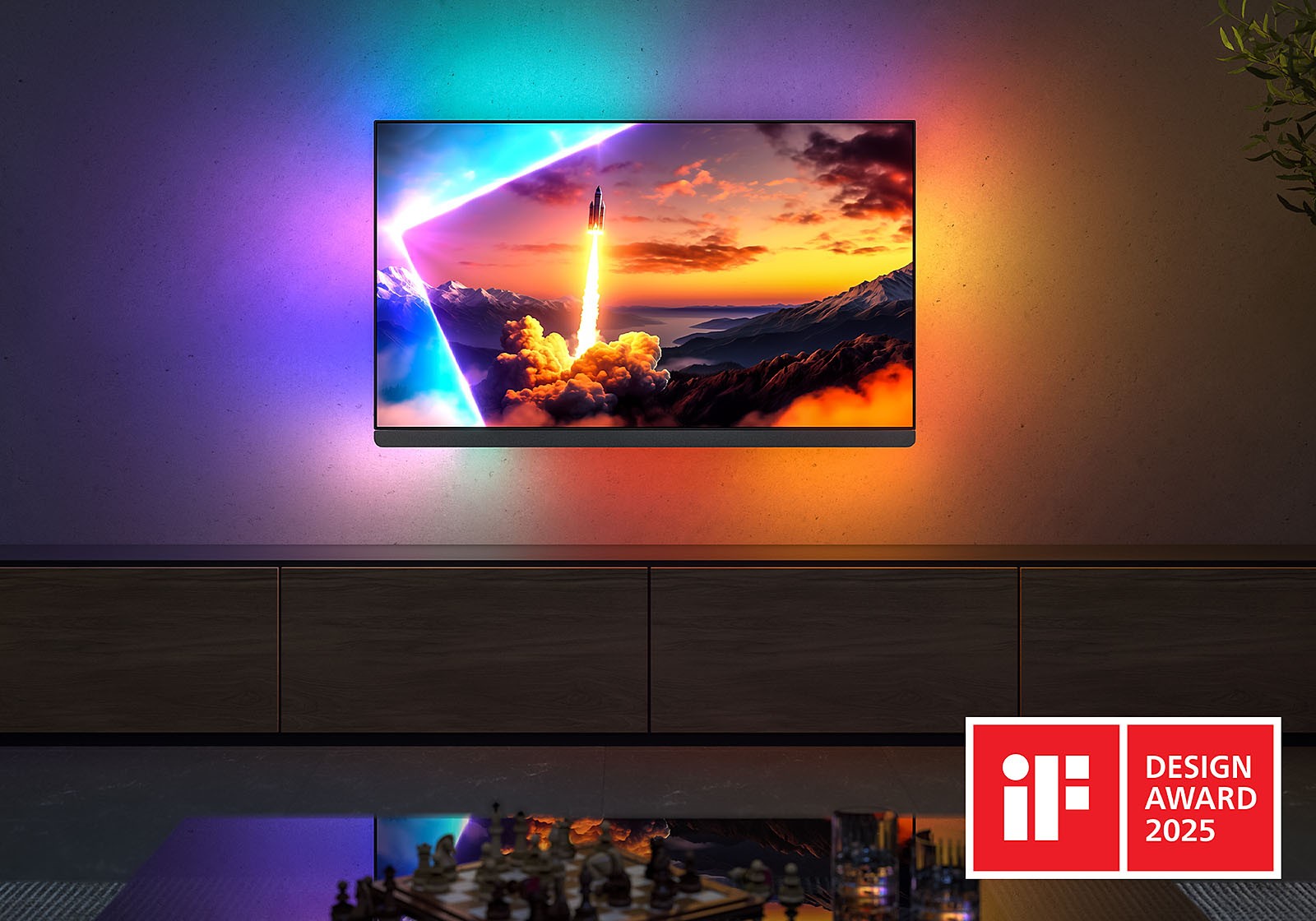The Philips OLED910 series has three models: the Philips 55OLED910 (55'', 140 cm), Philips 65OLED910 (65'', 165 cm) and Philips 77OLED910 (77'', 196 cm).
Philips OLED910, 3.1 sound section by Bowers & Wilkins££££
The Philips OLED910 TVs feature a 3.1 sound section, also by Bowers & Wilkins. The LCR (Left, Center, Right) configuration for each channel is based around six custom-developed high-efficiency titanium dome front speakers (including two 30 x 50 mm [abc]midrange[/abc] drivers and a 19 mm Nautilus tweeter[/abc] driver). Precision, the acoustic package of each channel is isolated from the others in a rigid housing for efficient sound insulation, a wide soundstage and perfectly intelligible dialogues. At the rear is a 75 mm subwoofer, supported by four passive membranes. The maximum power delivered, through 8 digital amplification channels, displays 81 watts.
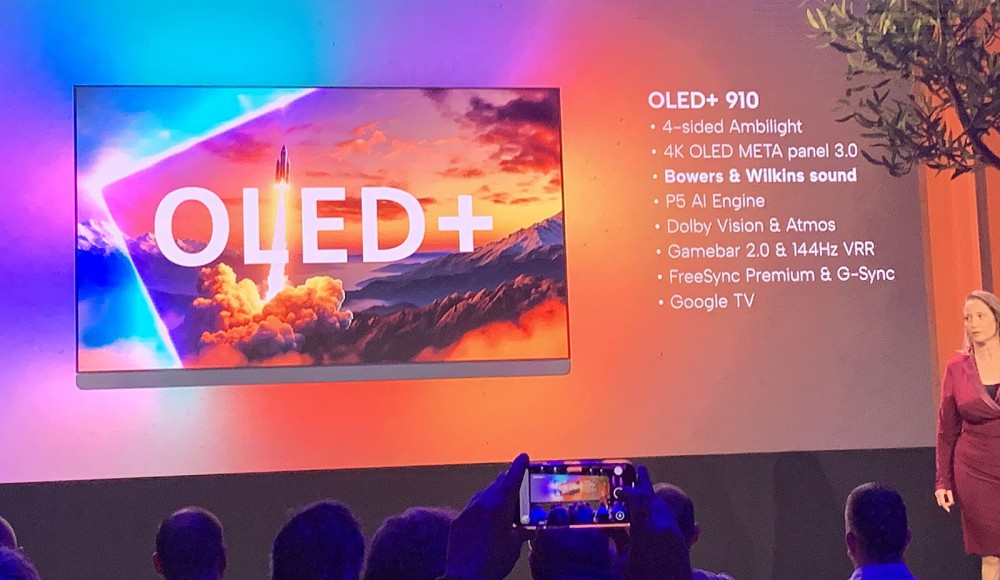
In short, if the sound specifications are identical to those of the Philips OLED909 TVs vintage 2024, the Philips OLED910 TVs should do better thanks to the performance of the onboard [abc]DSP[/abc], optimized through a new [abc]Firmware[/abc]. The Philips OLED910 TVs can accommodate a subwoofer as reinforcement for those who would like it. Finally, the front audio equipment is grouped in a sound bar located under the TV panel, and covered in slate-colored Kadvrat Audiomix fabric.
Philips OLED910, 4-sided Ambilight function ££££
The four-sided Ambilight function is available on Philips OLED910 TVs. For three years now, this has managed the color diodes placed on the back of the TV, around the edge of the panel, independently and no longer in groups of diodes, for significantly more precise synchronization with the images displayed on the screen.
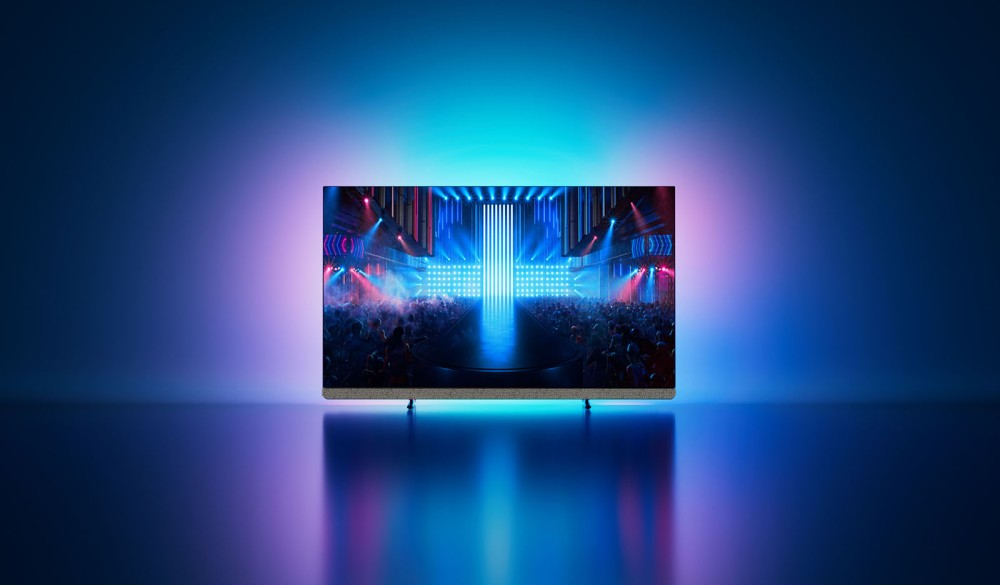
Philips OLED910, P5 Gen9££££
On the menu for Philips OLED910 TVs, the ninth generation of the P5 processor with new artificial intelligence features. In addition to Deep Learning and Machine Learning attributes via the AI Adaptive Intelligence process, the processor is now able to optimize its performance from additional data: metadata, source information, analysis of a complete image, detection of the environment, big data learning…
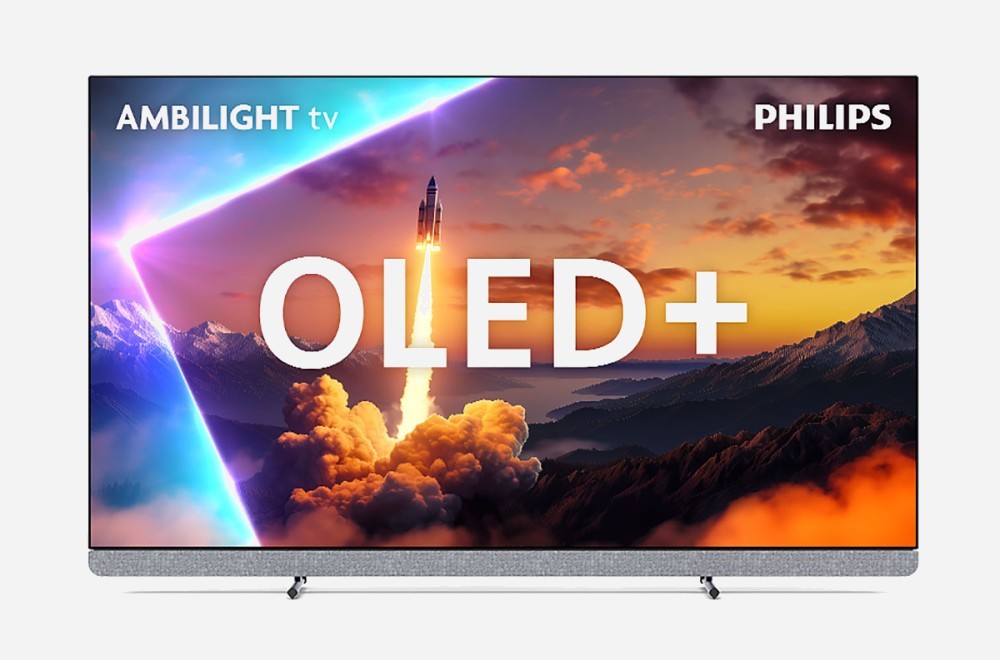
The new AI Adaptive Gamut Enhancer feature, specifically designed for Rec.709 sources, optimizes color rendering to fully exploit the wider colorimetric potential of the new Oled EX panel, for more vivid saturation without affecting skin tone. This color enhancement setting is accessible to the user and can be adjusted to suit their taste: natural, balanced and vibrant.
Philips OLED910 TV, new Game Bar 2.0££££
Of course, the Game Bar is still present on the Philips OLED910 TVs but in a 2.0 version, that is to say offering access to the Cloud Gaming services Blacknut and Boosteroid. Otherwise, it allows users to quickly access game-related settings and change them on the fly without wasting time. The native 144 Hz panel, MEMC Gaming motion compensation processing and 120 Hz Dolby Vision Gaming HDR, offer an exceptional video gaming experience. The player can choose from several game profiles (FPS, RPG, etc.). The same goes for Ambilight. Namely, the Game Bar 2.0 displays an fps counter (number of frames per second) to best configure the settings of a game. FreeSync Premium and G-Sync certifications are required.
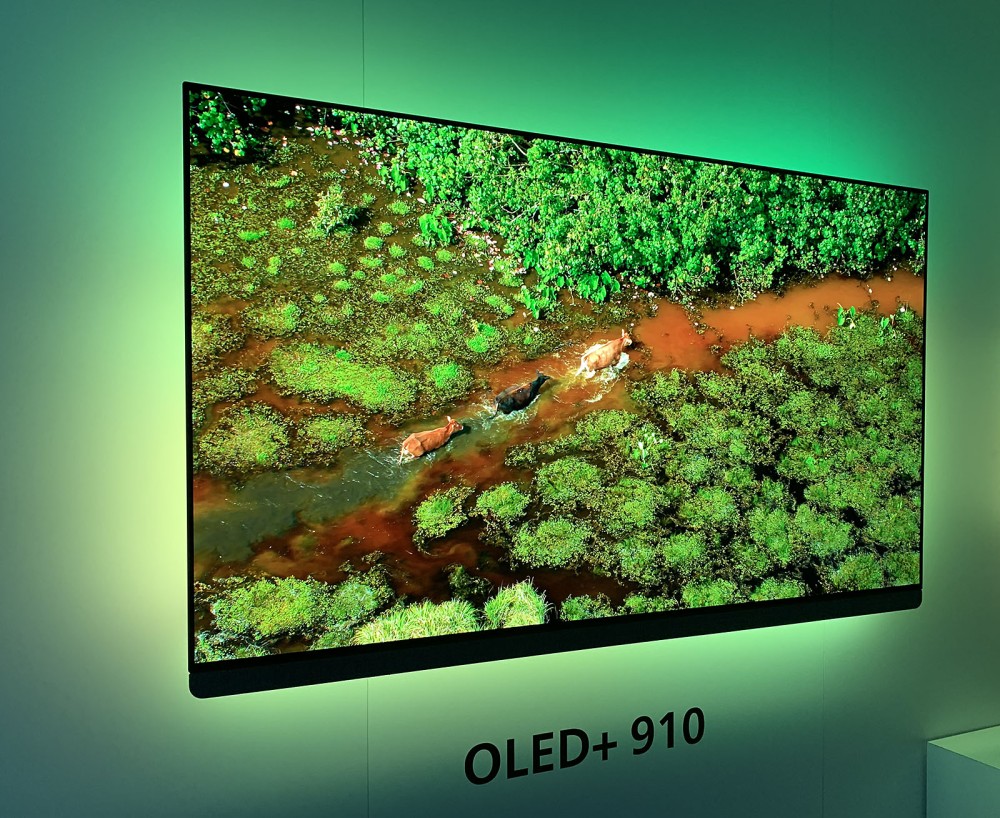
Also to know for the Game Bar 2.0, in the presence of the most popular games on the market, it recognizes their title and applies the associated optimized settings. It is also possible for the user to save a specific audio-video setting according to their games. Subsequently, the television will recognize the displayed game and automatically apply the saved settings. Finally, the Game Bar 2.0 allows a careful choice of display colors within a wider panel and various filters.
Philips OLED910 TV, Oled Meta 3.0 panel££££
Behind the Meta 3.0 name of the Philips OLED910 TVs are hidden the new Oled Tandem Primary RGB panels based on a new structure with four layers of organic emitting materials, including two layers of blue materials. Surprise, the composition of these layers is ultimately not the one announced at the beginning of January during the presentation of this new technology at the CES 2025 show in Las Vegas. LG Display's recent statement on this subject contradicts the information gathered on site (see our CES 25 news > Oled Primary RGB Tandem 4,000 nits panel, have we been lied to?), the blue emitting elements being (late) announced still of the fluorescent type and not phosphorescent. The combination of these two blue emitters, mixed with the other red and green phosphorescent organic emitting materials with deuterium (a material already used since the appearance of Oled EX panels in 2022), refines the wavelength of light and improves color purity to offer increased performance in terms of brightness but also color volume. LG Display has continued to perfect this last point, an intrinsic weakness of White Oled technology. We can't wait to judge the brand's claims.

Another advantage highlighted by Oled Tandem Primary RGB technology is a reduced risk of marking (pixel burn-in). Again, this is a point on which LG Display has been working hard since the beginnings of Oled technology. And while significant progress has been made in recent years, the problem persists during specific uses (long video game sessions or broadcasting a news channel with a banner at the bottom of the screen, for example). The Tandem Oled process would be the most significant advance on the subject since the launch of Oled.
In the end, thanks to Tandem Oled RGB technology, the peak brightness of Philips OLED910 TVs is approximately three times greater than that of Philips OLED909 TVs (Editor's note: for a 10% APL). Another figure, Philips OLED910 diffusers offer, for a 100% APL (i.e. a completely white screen), a brightness of 350 nits for a peak at 3,700 nits. Finally, the use of Meta 3.0 technology blocks 99% of light reflections on the panel, in addition to those inside the panel for significantly better color quality even with a very bright signal, in addition to lower energy consumption, down by around 20%.

Philips OLED910 TV, connectivity ££££
Everything is coming! In 2025, we find on Philips OLED910 TVs four [abc]HDMI[/abc] 2.1 inputs with [abc]eARC[/abc], [abc]VRR[/abc] (from 40 Hz to 120 Hz), [abc]HFR[/abc] 4K/120 and [abc]ALLM[/abc] compatibility.
Philips OLED910 TV, HDR10+ Adaptive, HDR HLG and HDR Dolby Vision££££
Apart from the brilliant Ambilight process in its four-sided version, compatibility with [abc]HDR Dolby Vision[/abc] up to [abc]Ultra HD[/abc] [abc]4K[/abc] and 120 Hz, HDR [abc]HLG[/abc] and [abc]HDR10+[/abc] Adaptive technologies, are still available on the Philips OLED910 screens. The same goes for the Smart Google TV function, the new Moments application allowing you to quickly transfer your favorite photos stored on your smartphone to the big screen and add visual and sound effects, as well as Matter and Control4 compatibility.
More details in a future news item. Commercial release planned for June. Indicative prices: €2,499 for the Philips 55OLED910, €3,499 for the Philips 65OLED910 and €4,999 for the Philips 77OLED910.
Reminder of the key characteristics of Philips OLED910 TVs:
• 10-bit panel
• [abc]Ultra HD[/abc]/[abc]4K[/abc] panel• 144 Hz panel
• [abc]Oled[/abc] Meta 3.0 panel
• Oled Primary RGB Tandem panel
• Processor: P5 Perfect Picture Engine Gen9 (AI)
• P5 Perfect Sharpness Ultra Resolution function
• P5 Perfect Contrast function
• P5 Perfect Color function (WCG, Wide Color Gamut)
• Ambilight + Hue function
• Perfect Natural Reality function
• [abc]eARC[/abc] function
• Imax Enhanced function
• [abc]VRR[/abc] function
• [abc]ALLM[/abc] (Auto Low Latency Mode)
• 4K [abc]HFR[/abc] 120
function• Game Bar 2.0 function
• [abc]HDR10[/abc] and [abc]HDR HLG[/abc] compatibility
• [abc]HDR10+[/abc] compatibility
• [abc]HDR Dolby Vision[/abc] compatibility
• HEVC compatibility
• [abc]Dolby Atmos[/abc] compatibility
• [abc]DTS:X[/abc] compatibility
• [abc]Fransat[/abc] compatibility
• [abc]AV1[/abc] compatibility
• [abc]VP9[/abc]
• G-Sync Compatibility
• DTS Play-Fi Compatibility
• [abc]HDCP[/abc] 2.3 Compatibility
• [abc]Wi-Fi[/abc] ax Compatibility
• HDR10+ Adaptive Compatibility
• FreeSync Premium Compatibility
• [abc]Bluetooth[/abc] 5.2 Compatibility
• HDR Dolby Vision 120 Hz Gaming Compatibility
• HGiG Compatibility
• [abc]Chromecast (built-in)[/abc] Compatibility
• [abc]ISF Certification[/abc]
• Filmmaker Mode Certification
• Outputs: 1 [abc]optical[/abc], 1 Subwoofer Pre-Out
• Inputs: 2 [abc]HDMI[/abc] 2.1, 2 [abc]HDMI[/abc] 2.0, 1 [abc]Composite[/abc], 2 [abc]USB[/abc] ports (including one 3.0), 1 [abc]Ethernet[/abc] port, 1 [abc]CI+[/abc]
port• Multimedia [abc]AirPlay 2[/abc]
• HomeKit multimedia
• Google Assistant multimedia
• Works with Alexa multimedia
• Google TV multimedia
• Perfect Natural Motion motion compensation
• Input Lag: 16 ms with a 60 Hz signal, 8 ms at 120 Hz
• Bright peak: 3,700 nits (3% white)
• Tuner [abc]DVB-T[/abc]2
• Tuner [abc]DVB-C[/abc]
• Tuner [abc]DVB-S[/abc]2
• Sound section: [abc]3.1[/abc]
• Power: 81 W
